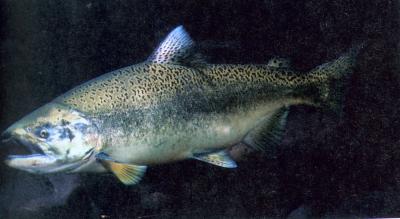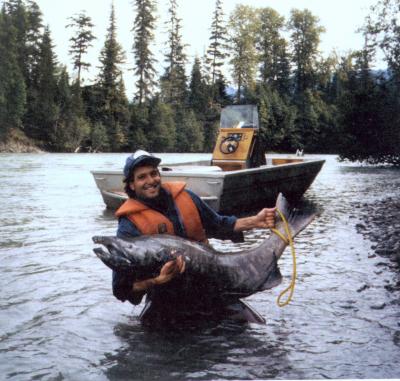April 14, 2005
To sea or not to sea? Some chinook salmon stay and succeed
The ones that stay and the ones that stray are biological puzzles among Pacific salmon, of whom the vast majority — but not all — travel thousands of miles to sea and back to the streams where they hatched.
There are chinook salmon populations in Idaho in which an occasional male stays put and matures when only 6 inches long — that is, he’s able to fertilize eggs at even that diminutive size, says Thomas P. Quinn, UW professor of aquatic and fishery sciences and author of a recently released book published by University Press, The Behavior and Ecology of Pacific Salmon and Trout.
Just picture that tiny male under the belly of a 20-pound adult female that has returned to spawn, Quinn says. He’s almost as likely to be a “winner” as the full-size males that are releasing their sperm in a competitive frenzy as the female deposits her eggs.
And the tiny male has avoided the harrowing journey taken by most salmon to the ocean and back, bypassing hazards such as dams, sharks and fishermen.
“In some species, all or a fraction of the individuals in some populations do not migrate to sea at all,” he says. “These fish sacrifice the growing opportunities at sea for the relative safety of freshwater, and males are more inclined to remain than females. This difference is related to the fact that reproductive success in females is linked to the ability to produce numerous large eggs, hence the need for the female to be of a certain size herself.
“Small males, however, can sometimes fertilize many eggs by sneaking rather than by fighting,” Quinn says in the chapter called, “Downstream Migration: To Sea or Not to Sea?” The evidence for this is in the DNA of the resulting offspring.
It should be pointed out that salmon are not “thinking this out” in any cognitive way, that there are some genetic controls at work that scientists don’t fully understand, he says.
The same is true of fish that have gone to sea but don’t return to their stream of origin to spawn, instead straying to some other waterway.
The process of straying is entirely mysterious, Quinn says. Do strays identify the home stream but then go elsewhere? Do they have poorer memory or sensory capabilities and so stray out of ignorance? Or are there other factors involved?
“These strays are not merely an aberration to be ignored. Much of the present range of Pacific salmon was covered by thick glaciers some 10,000 to 15,000 years ago, so most current populations were founded by strays since then. Thus straying is just as fundamental an attribute of salmon as homing,” he says.
“Perhaps the offspring should be called strays only if they are unsuccessful when it comes time to reproduce, and colonists if they are successful.”
From an evolutionary perspective, a mixture of homing and straying by offspring is a way that parents can spread the risk because offspring don’t spawn in the same place. One of Quinn’s hypotheses is that adults spawning in less predictable streams and rivers — ones where conditions are good some years and bad in others — may be genetically inclined to produce more offspring that are likely to stray.
Then there are salmon like the chinook, where brothers and sisters from the same parents don’t mature and return from sea at the same time, a way of “straying in time” so that a given pair hasn’t lost all their descendants if one year’s worth is wiped out.
There is undoubtedly an environmental aspect in all of these, he says, the most obvious being when conditions in the home river are so degraded that salmon move elsewhere to spawn.
Straying is just one of the traits that cause Quinn to say that salmon have chances to recover from years of declines “if we would only take our collective foot off their neck.”
Quinn writes in the conclusion to his book, “A great deal of habitat from southern British Columbia to California is no longer accessible to salmon or has been altered to their detriment. However, if we write salmon off as incapable of recovery and so justify actions and inactions that harm them, we will turn our pessimism into their reality, and that would be unforgivable.”


